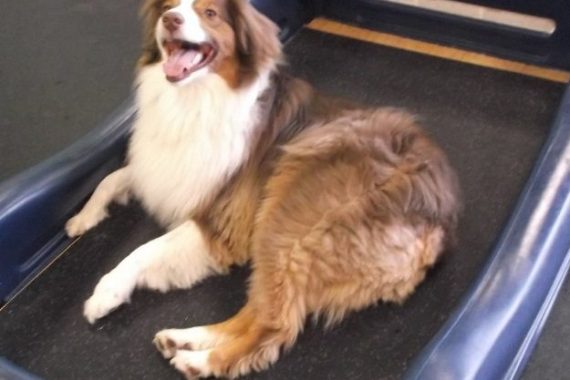Summer’s a Good Time for Doggie Daycare

Most dogs don’t do well in the heat. Like you, they need to adjust their routines for summer, because hot weather stresses their bodies. Dogs do not sweat through their skin like we do to cool down; instead, dogs will sweat through their paw pads, and pant to regulate their body temperature. Through most of the year, panting is sufficient to keep cool, however during the heat, that can quickly change. Dogs don’t know they’re getting overheated, and an energetic dog, like a retriever, will continue to play until they drop. A small dog can overheat in minutes if left in the heat. Dog owners must always exercise caution when their dogs are outside in the sun. Dogs with short coats and/or sensitive skin need even more attention and care due to the fact that they can easily get sunburned.
Overheating can be fatal in a dog if you don’t know the signs and seek immediate treatment. Overheated dogs can suffer like humans from heat exhaustion, heat stroke, or a fatal rise in body temperature.
If you have a brachycephalic dog like a bulldog, shitzu, boxer, or a pug, don’t leave him alone in the back yard even for five minutes during summer days. Dogs with pushed in faces are cute, but they have lots of respiratory issues, including being inefficient panters. A dog with a more conventional face and throat is able to pass air quickly over their tongue through panting. Saliva evaporates from the tongue as air is passed across and the blood circulating through the tongue is efficiently cooled and circulated back to the rest of the body. But in the brachycephalic dog, so much extra work is required to move the same amount of air that the airways become inflamed and swollen. This leads to a more severe obstruction, distress, and further overheating. These dogs don’t breathe easily under the best of conditions, and they should only be in a climate-controlled environment over the summer.
Learn the signs of overheating: excessive panting, followed by disorientation and fast noisy breathing. Some dogs even collapse, convulse, vomit, or have diarrhea. If you see these symptoms, you must cool the dog off immediately and then take him to the vet. To check for dehydration, lift and pull the skin behind your dogs ears and let go. If the skin stays ‘tented’, then your dog is likely dehydrated. Pale, sticky gums are also an indication of dehydration, and you should take your dog out of the heat and give them some water! Dehydration alone, unless severe, does not require a vet visit; however, if any of the symptoms above are also apparent, they should be taken to the vet.
To avoid overheating and dehydration, you must change up the time of day you walk your dog and arrange for shorter walks. If you have a dog sitter or a dog walker, remind them not to walk your dog on concrete or asphalt during the summer unless it’s after dark, and to shorten the walk. If there’s nothing but a hard surface around for your dog, at least invest in a pair of dog socks.
Dog day care facilities, like Dogtopia, have climate controlled playrooms year round to make sure your dog gets the proper level of exercise, but no exposure to hot weather. For the summer Dogtopia is a great alternative to off-leash parks.











